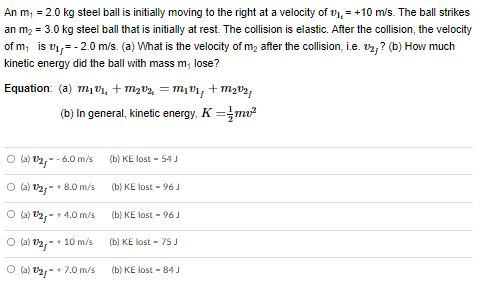An m1 = 2.0 kg steel ball is initially moving to the right at a velocity of v14 = +10 m/s. The ball strikes an m2 = 3.0 kg steel ball that is initially at rest. The collision is elastic. After the collision, the velocity of m1 is v1f = −2.0 m/s. (a) What is the velocity of m2 after the collision, i.e. v2f? (b) How much kinetic energy did the ball with mass m1 lose? Equation: (a) m1v1i + m2v2i = m1v1f + m2v2f (b) In general, kinetic energy, K = 12 mv2 (a) v2f = −6.0 m/s (b) KE lost = 54 J (a) v2f = +8.0 m/s (b) KE lost = 96 J (a) v2f = +4.0 m/s (b) KE lost = 96 J (a) v2f = +10 m/s (b) KE lost = 75 J (a) v2f = +7.0 m/s (b) KE lost = 84 J
